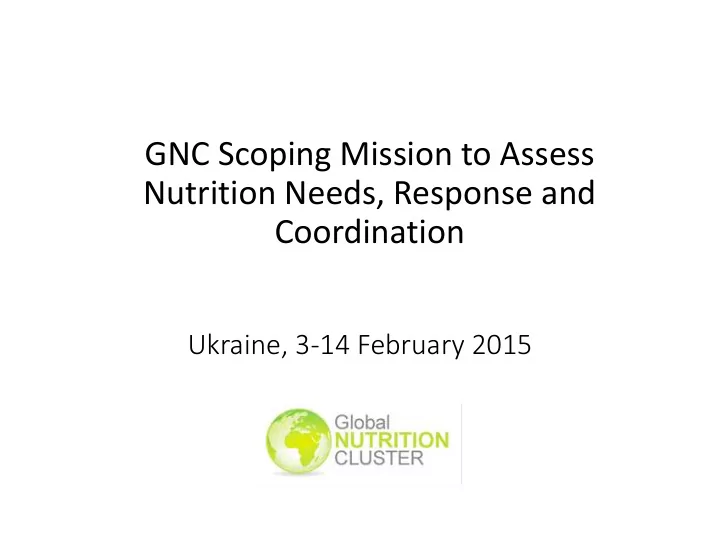

GNC Scoping Mission to Assess Nutrition Needs, Response and Coordination Ukraine, 3-14 February 2015
Objectives of Mission • To review nutrition coordination structure • To identify and map capacity of partners • To map nutrition interventions • To assess nutrition information needs and the possibilities for conducting nutritional assessment • To identify programmatic and geographic areas of need and key NiE interventions • Identify core advocacy concerns related to NiE interventions
Methodology • Documents review (assessment reports, regional reports, surveys, situation reports, press releases, media articles) • One-on-one consultations with 27 individuals • Additional review of documents shared by key informants • SRP workshop, two operational planning meetings, two FS&N Cluster meetings, two Health Cluster meetings and a WASH Cluster meeting attended
Nutrition Situation Pre-Crisis • GAM prevalence 1.3% (2000) • Anaemia prevalence pre-crisis 22.2% (2004); no information on other MND but expected to be common • IYCF practices sub-optimal, ex. Exclusive BF 19.7% (2012), wide use of BMS • No info on other population groups
Infant feeding patterns by age, Ukraine, 2012
Im Importance of f Protecting In Infant and Young Chil ild Feeding in in Emergencies • Breastfed children healthier than non-breastfed children in all contexts – even non-emergency • In emergencies disease & death rates for < 5s significantly higher due to: ↑ communicable diseases, ↑ undernutrition, lack of appropriate health care • Difficult unsanitary conditions + risk of water borne disease • BF confers critical protection from infection and death especially in emergencies when lack of safe water & poor sanitation • Artificial feeding even riskier in in emergencies significantly endanger infant & young children’s health and lives
Im Importance of f Protectin ing In Infant and Young Chil ild Feedin ing in in Emergencies • Even when safe water guaranteed, infant formula use has high risks: - deprives infants of disease prevention/fighting action of breast- milk - retards development of the immune system - renders babies more susceptible to colonisation by pathogens • BMS should only be provided to targeted infants who have been assessed by a qualified health/nutrition worker • Additional resources, training and support for caregivers to minimise the risks of artificial feeding • Once started, provision of BMS must continue as long as infant requires • Spill over risks of BMS programmes high, so interventions to support non-breastfed infants should always include component to protect BF
WHO/UNICEF recommendatio ion on IY IYCF • infants should initiate exclusive breastfeeding within one hour of birth • and continue exclusively breastfeeding for the first six months of life. • After this time, infants should continue breastfeeding until they are two years of age or beyond while also receiving age-appropriate, nutritious and hygienic complementary foods.
WHO/UNICEF recommendatio ion on IY IYCF • Introduction of complementary foods at 6 months of age • Semi-solid, nutritious foods providing not only required energy, but also vitamins, minerals and high quality (animal) protein • Thick porridges, soft fruits and vegetables, minced meat/chicken/eggs • Gradual transition to family foods around 1 year of age
Mission Findings – Nutritional status No info on acute malnutrition • Expected to increase, due to aggravation factors (deterioration of food security, WASH and health situation, care practices, access to basic services) • Reports that children are unhealthy, pale, not active, however no confirmed reports of acute malnutrition No info on MNDs • Expected to increase due to very limited access to fruits, vegetables, fish and meat
Mission Findings – IYCF-E • Lack of info on current IYCF practices • Non-existent capacity of partners and gvt in NiE, incl. IYCF • “Baby baskets” contradict WHO/UNICEF recommendations • Widespread BMS distributions • Reports that mothers stop BF because of the stress, strong believes that mothers do not have enough milk to BF • Sub-optimal complementary feeding • Early introduction of CF • Very limited access to MN-rich food • Limited access to protein-rich food • Focus on industrial CF • High demand for BMS and CF
Mission Findings – other factors Risks of increased morbidity, malnutrition amplified by current conditions: - deteriorated water quality and supply - decreased sanitation and hygiene - lack of safe and appropriate complementary foods - lack of available food, especially MN and protein- rich -decreased access to health services - low exclusive BF rates - lack of skilled support for appropriate IYCF
Mission Findings – Response and Coordination • Nutrition was part of the FS and Nutrition Cluster • No coordination/IM capacity for nutrition • One NGO distributes BMS and one NGO distributes CF&BMS • Some potential partners on the ground identified (local NGOs, INGOs, UN agencies, gvt) • Non-existent capacity of partners and gvt in NiE • No nutrition assessments conducted, Save was planning IYCF assessment • SRP was revised during the mission
Recommendations – Response • Technical capacity in nutrition of CLA and leading partners should be enhanced • Build capacity of partners in NiE • Conduct IYCF assessment, discuss need for other assessments • Develop and agree upon cluster strategy, focus on quick wins • Focus on children, PLW and older people • Implementation in partnership with other clusters/sectors and gvt • Orient hum. community on NiE • IYCF statement and communication campaign
Recommendations – Coordination • Create Nutrition Sub-group under Health cluster •Bring everyone “on the same page” • UNICEF start recruitment of NCC and deploy RRT • Build sub-national presence • Advocate to INGOs with NiE expertise to implement nutrition programming
Recommend
More recommend